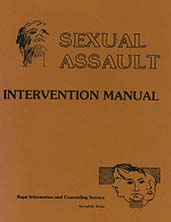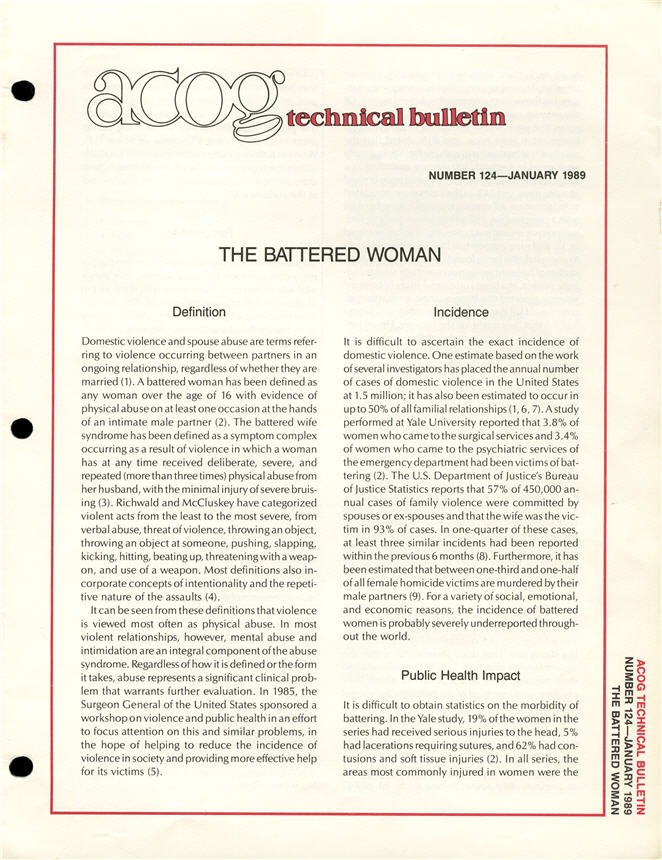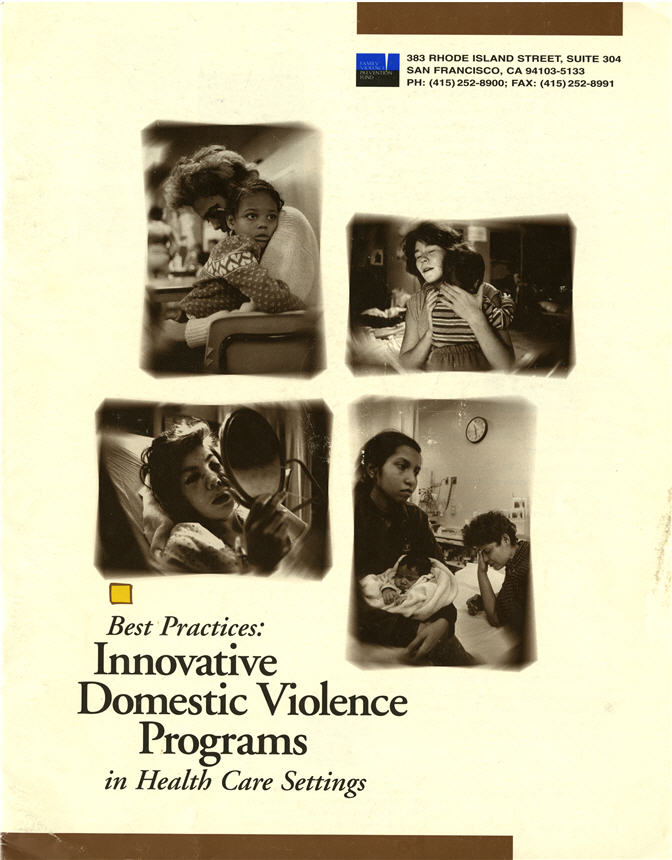Nurses changed the way the medical profession identified and treated women who were battered. By the 1990s, all the major medical organizations recognized domestic violence as a significant health issue and urged their members to take action, reinforcing over a decade of advocacy by nurses and their allies.
While these reforms were significant and helped to save and improve lives, the work of ending violence in American homes continues to this day. As individuals and community members, we all have a part to play in confronting violence and improving women’s lives. Together we can make a difference.
The American College of Obstetricians and Gynecologists define for member physicians “The Battered Woman,” 1989
Courtesy American College of Obstetricians and Gynecologists
The American College of Obstetricians and Gynecologists’ first bulletin on domestic violence outlined the definition, incidence, and public health impact of abuse, and stressed the importance of identifying victims and providing methods for medical intervention.
“American Medical Association Diagnostic and Treatment Guidelines on Domestic Violence,” Archives of Family Medicine, 1992
Courtesy National Library of Medicine
The Archives of Family Medicine journal published the American Medical Association’s guidelines on domestic violence, marking a critical turning point in the history of medicine. Pioneer physician reformer Anne Flitcraft co-authored the guidelines.
The American College of Obstetricians and Gynecologists announced a campaign to combat domestic violence in 1989
Courtesy National Library of Medicine
The American College of Obstetricians and Gynecologists declared domestic violence a priority health issue, stating that all 27,000 members would receive information on how to detect victims of violence and how to help them.
Best Practices: Innovative Domestic Violence Programs in Health Care Settings, Janet Nudelman, Nancy Durborow, Marya Grambs, and Patrick Letellier, 1997
Courtesy National Library of Medicine
Published by the Family Prevention Fund, the practices outlined here reflect over a decade of medical reform initiated by nurses, physicians, social workers, and public health officials to improve the response to and treatment of women who were battered. The Fund and their CEO, Esta Soler were critical in improving the healthcare response to women and girls who were abused.
Camera body, a component of an imaging system designed to capture both internal and external injuries, Secure Digital Forensic Imaging, 2014
Courtesy Secure Digital Forensic Imaging, SDFI-Telemedicine LLC
Tools used by nurses to document patient trauma have become more sophisticated as the practice of forensic nursing and the investigation of abuse crimes have become standardized. The SDFI camera captures internal injuries that are otherwise not visible to the naked eye. These images help to document the complete injury and suggest the severity of abuse.
The American College of Obstetricians and Gynecologists define for member physicians “The Battered Woman,” 1989
Courtesy American College of Obstetricians and Gynecologists
The American College of Obstetricians and Gynecologists’ first bulletin on domestic violence outlined the definition, incidence, and public health impact of abuse, and stressed the importance of identifying victims and providing methods for medical intervention.
“American Medical Association Diagnostic and Treatment Guidelines on Domestic Violence,” Archives of Family Medicine, 1992
Courtesy National Library of Medicine
The Archives of Family Medicine journal published the American Medical Association’s guidelines on domestic violence, marking a critical turning point in the history of medicine. Pioneer physician reformer Anne Flitcraft co-authored the guidelines.
The American College of Obstetricians and Gynecologists announced a campaign to combat domestic violence in 1989
Courtesy National Library of Medicine
The American College of Obstetricians and Gynecologists declared domestic violence a priority health issue, stating that all 27,000 members would receive information on how to detect victims of violence and how to help them.
Best Practices: Innovative Domestic Violence Programs in Health Care Settings, Janet Nudelman, Nancy Durborow, Marya Grambs, and Patrick Letellier, 1997
Courtesy National Library of Medicine
Published by the Family Prevention Fund, the practices outlined here reflect over a decade of medical reform initiated by nurses, physicians, social workers, and public health officials to improve the response to and treatment of women who were battered. The Fund and their CEO, Esta Soler were critical in improving the healthcare response to women and girls who were abused.
Camera body, a component of an imaging system designed to capture both internal and external injuries, Secure Digital Forensic Imaging, 2014
Courtesy Secure Digital Forensic Imaging, SDFI-Telemedicine LLC
Tools used by nurses to document patient trauma have become more sophisticated as the practice of forensic nursing and the investigation of abuse crimes have become standardized. The SDFI camera captures internal injuries that are otherwise not visible to the naked eye. These images help to document the complete injury and suggest the severity of abuse.
Nurses changed the way the medical profession identified and treated women who were battered. By the 1990s, all the major medical organizations recognized domestic violence as a significant health issue and urged their members to take action, reinforcing over a decade of advocacy by nurses and their allies.
While these reforms were significant and helped to save and improve lives, the work of ending violence in American homes continues to this day. As individuals and community members, we all have a part to play in confronting violence and improving women’s lives. Together we can make a difference.












